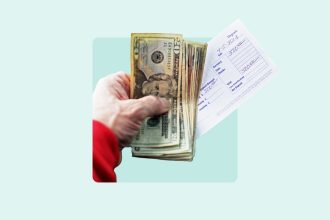dragana991/Getty Images; Illustration by Austin Courregé/Bankrate
Key takeaways
- Lenders tend to tighten credit requirements during tough economic times, making it harder to get approved for credit products, including loans.
- Credit score, income and debt-to-income ratio are the main factors lenders consider when reviewing applications.
- Paying down debts, increasing your income, applying with a co-signer or co-borrower and looking for lenders that specialize in loans within your credit band could increase your approval odds.
If you recently applied for a personal loan and got denied, you’re not alone. Bankrate’s Credit Denials Survey found that half of applicants who applied for a loan or other financial product have been denied since the Fed launched an 18-month rate-hike campaign that began in March 2022.
This is likely in part due to the fact that lenders tend to tighten their credit requirements during tough economic times to mitigate risks, which in turn makes it harder to get approved for a loan. Luckily, there are a few steps you can take to improve your approval odds, even in a tough economy.
Credit denial statistics
- 50% of Americans who have applied for credit products since the Fed rate hikes in March 2022 have gotten denied, according to Bankrate’s Credit Denials Survey.
- 17% were denied more than one loan or financial product.
- 21% of Americans say it has gotten harder to access credit since the Fed increased interest rates.
- New credit card applications, including balance transfer cards, accounted for the majority of credit denials at 19%.
- Credit card limit increase denials (at 11%) came in second, followed by personal loans (at 10%).
Reasons for personal loan rejections
There are several reasons someone may have their loan application rejected, including bad credit, a large amount of debt or an unreliable source of income.
Bad credit history
Bad credit history may indicate to creditors that you are having or had trouble repaying what you owe based on past transactions. Although your credit score is generally a good indicator of credit history, lenders also look at your overall financial history to establish your creditworthiness.
High DTI
If you have a debt-to-income (DTI) ratio — or debt-to-income — ratio of 50 percent or higher, you might have too much debt for a lender to give you a new loan. If that’s the case, it’s best to apply after reducing your overall debt, as this will increase your chances of approval.
Incomplete application
Your loan rejection could be as simple as missing a key field or document needed for verification. If you are rejected for a loan, double-check that you fully completed the application and submitted all the required personal loan documentation.
Lack of proof of steady income
Consistency is key because it helps lenders understand your job landscape moving forward. Because jobs can vary depending on the line of work, lenders may look at tax returns to get a better overview.
Loan doesn’t fit the purpose
Lenders might have certain restrictions on what you can and can’t do with loan money. For example, some financial institutions don’t allow you to use a personal loan to cover post-secondary education expenses. The lender may be able to offer you alternatives to better fit your needs.
Unsteady employment history
Lenders like to see a steady income stream over time. If you are between jobs or have a history of unsteady employment, this could indicate to lenders that you may not be a reliable borrower.
When to apply for a loan again
Each time you apply for a loan or credit product there is a hard inquiry that can temporarily lower your score. That’s why it’s a good idea to wait at least 30 days before you apply again. However, if you don’t need the funds urgently, experts recommend waiting at least six months.
It’s also important to ask the lender why your loan was rejected before you submit another application. For example, if the lender says it was because your credit score was low or your DTI was too high, you could focus on improving those factors before applying again.
Why it’s been harder to get approved for a loan
Borrowers with good to excellent credit are still most likely to get approved for a loan, although the annual percentage rate (APR) lenders offer is likely to be much higher than it would have been last year.
Over the past few years, the Federal Reserve kept its benchmark rate at a 23-year high to combat persistent inflation. As a result, rates for mortgages, personal loans and auto loans rose. However, the Fed cut its benchmark rate by .50 percentage points at its September 2024 meeting.
Since the Fed cut rates, average personal loan rates may come down — but it will likely take some time.
How to improve your chances of qualifying for a loan
There are a few measures you can take to improve your approval odds when applying for a personal loan. But for any of these steps to work, you must know why you got denied in the first place.
Under the Equal Credit Opportunity Act, lenders must disclose the reason for denying your loan application as long as you inquire about it within 60 days of the decision. This is known as an adverse action notice. Knowing this information is key to developing an effective strategy to get approved next time.
Personal loan alternatives
If your personal loan application is denied, there are several personal loan alternatives to consider, including:
- Home equity loans: Similar to personal loans, home equity loans come with fixed rates and a lender issues you a lump sum if approved. Since the loan is secured by your home, you may find it easier to qualify with bad credit. That said, a significant downside to consider is that you could lose your home if you default on a home equity loan.
- Home equity lines of credit: A home equity line of credit (HELOC) is another way to tap your home’s equity. This product allows you to borrow against your home’s equity as needed — up to your credit limit. But like a home equity loan, you could risk losing your home if you default.
- Cash advance apps: If you need to borrow a small sum to tide you over until your next pay day a cash advance app could be an excellent solution. Most cash apps don’t require credit checks, so you could qualify for a short-term loan even with poor credit.
- Buy now, pay later loans: A buy now, pay later (BNPL) loan could be a solid alternative if you want to break a purchase into installments. Some retailers partner with BNPL apps that allow you to purchase an item immediately online. After making the purchase, you typically repay the loan by making four interest-free payments over two-week periods — though terms vary.
- Emergency loans: There are some lenders that offer emergency loans to cover an unexpected expense. These are processed quickly, and you may be eligible even with bad credit.
Bottom line
If you have been denied a loan, take the time to review your application and see what went wrong. Then, work on improving the aspects that got you denied in the first place.
If you’re in a crunch, there are lenders that offer loans to those with bad credit. Be sure to carefully consider the interest rates and your ability to make payments before you apply.
Read the full article here














